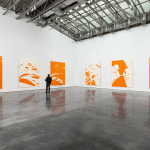In the Philadelphia Inquirer Edith Newhall reports that Bruce Pollock’s new paintings at Fleisher/Ollman Gallery represent a two-dimensional distillation and multiplication of the sculptures he made in the early 1980s. “They employ some of the same geometry (albeit a miniaturized version) and sublime coloration as the sculptures. But you could also argue just the opposite – that the fractals of minuscule patterns in his paintings appear to inhabit a vast, uncontained, infinite space. Nothing is what it initially seems to be in Pollock’s paintings. You might assume that six square paintings, each an exploration of a single color using several shades of several hues of the same family and comprising mostly circular forms, would share some other organizing principle. They do not. Pollock’s imagery, suggestive of multiple mandalas, nuclei, or wildflowers in a field, seems to have multiplied organically, even with impunity. Look carefully, and you’ll see that some of those tinier circles have squeezed their way into these compositions like last-minute subway passengers.
“Another series of paintings on rectangular canvases also gives a first impression of having undergone some preliminary plotting and design. But when you study Pollock’s “Cube Net,” for example, its floating cubes are all different, and it’s the painting’s palette of pale violet, blue, and gray that makes it appear to be composed of precisely repeated patterns. Pollock’s tour-de-force is an ink-and-pencil drawing on an 8-inch-wide, 20-foot-long scroll of white paper, in which patterns of aggregations of rectangles give way to honeycomblike formations, which give way to multiple circles, and so on – produced, one imagines, like the surrealist game Exquisite Corpse played by one. It looks like sheet music and an aerial map of a city combined, and it’s clearly a Baedeker to Pollock’s micro/macro worlds.” Read more.
“Bruce Pollock: Figure,” Fleisher/Ollman Gallery, Philadelphia, PA. Through May 9.






















